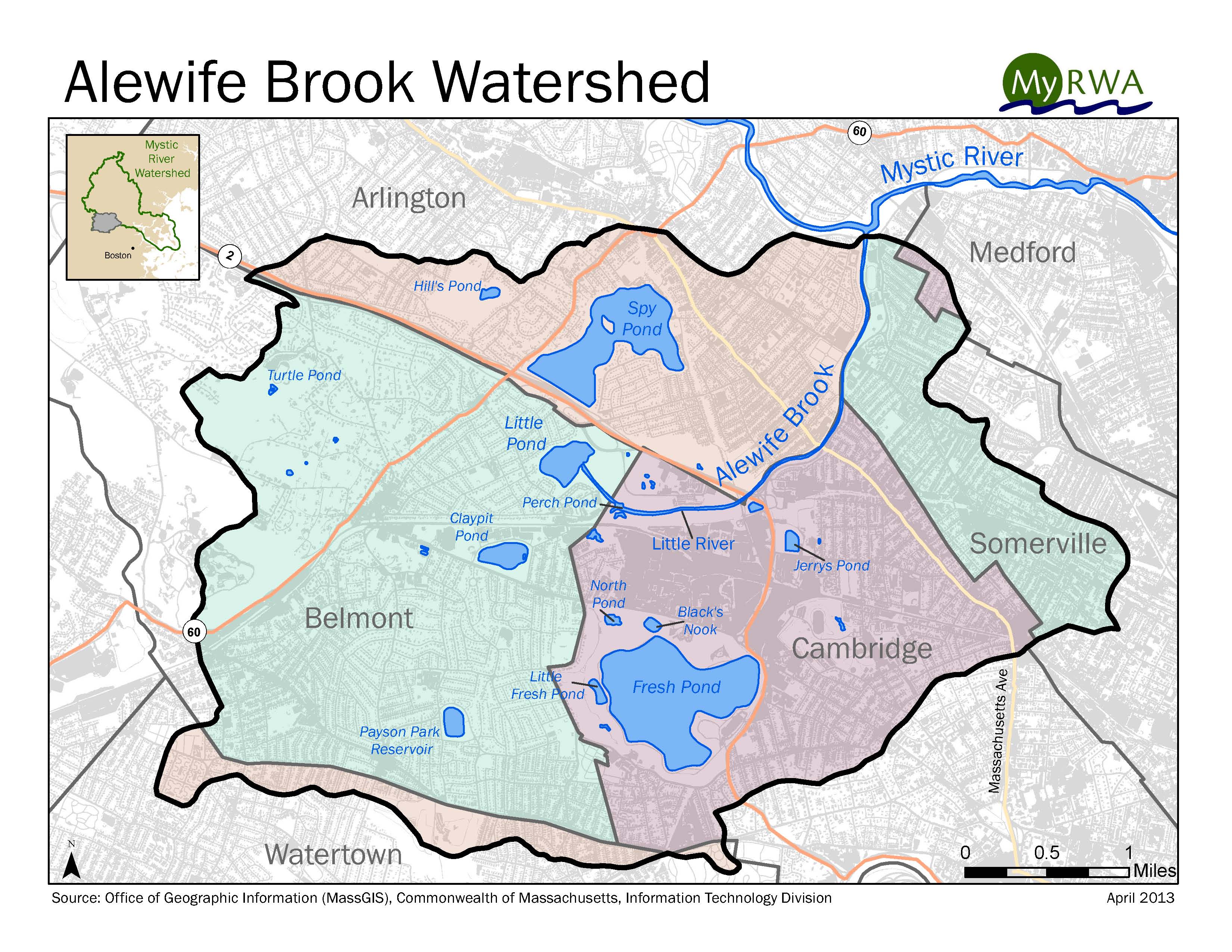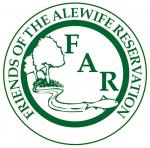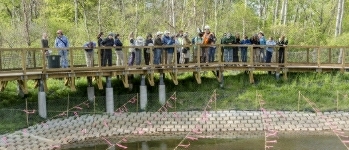from Mystic River Watershed Association website, accessed 2014-02-13
http://mysticriver.org/arlingtonbelmontgreenbmps/
NON-POINT SOURCE POLLUTION MANAGEMENT
OVERVIEW

Attendees at an Arlington public meeting identify locations for green BMPs
Attendees at an Arlington public meeting identify locations for green BMPs.
Through the Massachusetts Department of Environmental Protection (DEP), the Town of Arlington was awarded a
604(b) Water Quality Management Planning Grant in 2013.
The intent of 604(b) grants is to perform nonpoint source assessment and planning projects leading to the: 1) determination of the nature, extent and causes of water quality problems; 2) assessment of impacts and determination of pollutant loads reductions necessary to meet water quality standards; 3) green infrastructure projects that manage wet weather to maintain or restore natural hydrology; 4) development of designs and implementation plans that will address water quality impairments; and 5) development of assessment and remediation strategies in impaired watersheds in areas that are not regulated under Municipal Separate Storm Sewer Systems (MS4) permits.
WHO IS INVOLVED IN THIS PROJECT?
 Project partners include the Towns of Arlington and Belmont, MyRWA and Bioengineering Group. The Alewife Brook sub-watershed is the target area of this work – a watershed shared by the two towns as well as Cambridge and Somerville. MyRWA and BioEngineering Group worked on a similar 604(b) project in 2010-2012 with the cities and towns of Woburn, Winchester, Reading and Burlington – as part of this work, four conceptual designs were completed for ‘green’ Best Management Practices (BMPs) in the Aberjona River sub-watershed to promote rain water infiltration and address pollution.
Project partners include the Towns of Arlington and Belmont, MyRWA and Bioengineering Group. The Alewife Brook sub-watershed is the target area of this work – a watershed shared by the two towns as well as Cambridge and Somerville. MyRWA and BioEngineering Group worked on a similar 604(b) project in 2010-2012 with the cities and towns of Woburn, Winchester, Reading and Burlington – as part of this work, four conceptual designs were completed for ‘green’ Best Management Practices (BMPs) in the Aberjona River sub-watershed to promote rain water infiltration and address pollution.
WHAT IS THE PROBLEM BEING ADDRESSED?
The problem that the project is trying to address is a problem shared by almost every community in the watershed, state and country: non-point source pollution. Non-point source pollution is the mixture of pollutants picked up by rainfall as it moves through the soil and built environment. These pollutants include fertilizers (nutrients), herbicides, oil, grease, sediments, salt and bacteria (e.g. dog waste). When the pollutants reach the waterbody, they contribute to the degradation of these waterways for recreation and wildlife habitat. Degradation can include elevated bacteria levels that make recreation unsafe, high nutrient levels that yield development of algal blooms and invasive plants and a long-term decline in habitat quality.
Read more about non-point source pollution here.
PROJECT DETAILS
The Towns of Arlington and Belmont will work to identify the highest sources of stormwater runoff within their communities and begin planning for solutions to mitigate this impact. The municipalities, along with MyRWA, are taking a proactive approach toward identifying pollution sources and reducing pollutant loading through an examination of solutions with a focus on “green” structural Best Management Practices (BMPs).
Conceptual designs of five BMPs – three within Arlington and two in Belmont– will be developed to reduce pollutant loading from their respective sites to water bodies in the Alewife and Mill Brook sub-watersheds. The collaborative approach among the municipalities will allow the teams to share key expertise at a reduced cost, foster communication on the shared Alewife Brook and provide opportunities to learn from the projects completed in bordering towns.

Vegetated swales collect runoff and allow infiltration. EPA photo
Green Best Management Practices (BMPs)
Green BMPs represent an approach to wet-weather management that utilizes small-scale facilities, distributed throughout the watershed, to slow down, cleanse, infiltrate, and reuse rainwater where it falls. Specific BMPs that may be considered during our project include vegetated swales, bio-retention structures, permeable pavement, street trees and rainwater harvesting. Green BMPs – based on Low Impact Design (LID) principles - have demonstrated performance, cost effectiveness, and broad community benefits.
WORK PRODUCTS
- GIS Analysis – One analysis will identify key sub-basins within each community where pollutant loading is highest, targeting phosphorus; an additional analysis will focus on the priority drainage basins to identify which sites are feasible for BMP implementation and are optimally located to reduce downstream sediment and nutrient loading.
- Site Prioritization – Arlington and Belmont will create a list of potential sites for BMP retrofits. These sites will be compared to municipal goals and possible synergies with town activities, such as planned infrastructure work.
- Water Quality Monitoring - MyRWA will perform monitoring at one of the final BMP sites in each of the communities to estimate pollutant loading pre-installation.
- Final Conceptual Designs - Bioengineering Group will prepare conceptual designs for the BMP retrofits at each of the five top priority sites. The conceptual design report for each BMP will verify the engineering feasibility of the proposed BMP; estimate drainage and water quality benefits of the retrofit; provide conceptual level site plans and typical details for the BMP; and estimate construction and maintenance costs.
By the end of this project, Arlington and Belmont will be armed with conceptual designs and water quality data for key BMP retrofit locations. At this point, the project partners can then move on to pursuing implementation funds from local, state, federal and private sources, in addition to using their new skills in future work around town.
- Home
- Directions
- FAR Wildlife Blog
- Calendar
- News
- Donate Now
- Get Social!
- Storm Water Wetlands
- Plants and Restoration
- Photos
- Videos
- About & Projects
- Master Plan for Alewife
- Archive
- Newsletters
- Contact
 Presentation Spotlighting Alewife Reservation
Presentation Spotlighting Alewife Reservation
 Follow us on Twitter
Follow us on Twitter
 Like us on Facebook
Like us on Facebook
 Follow us on Instagram
Follow us on Instagram
Forward our web address to a friend!
- An Urban Gem - Alewife Reservation Nature Preserve
- Envisioning The Silver Maple Forest
- History and Policies of Cambridge, Belmont, and DEP
- Storm Water Wetlands
- Friends of Alewife Reservation brochure
(front, back) - Technical Analysis of Upper Alewife Basin
- Watershed: An Excursion in Four Parts
- The River Is A Restless Spirit: Life in the floodplain forest
-
Assessment of Silver Maple forest for DEP Adjudicatory hearings and
Patrick Fairbairn, author of the Assessment - Community Native Garden Flora
The
Alewife Reservation
is a unique natural resource for the communities of Belmont, Arlington and Cambridge
and home to hundreds of species, including hawks, coyotes beavers, snapping turtles, wild turkeys and muskrats,
the reservation is a unique natural resource for the community.
Historical information (Powerpoint)
Friends of Alewife Reservation works to protect and restore this wild area and the surrounding area for the water quality, native plants, animals and over 90 bird species with paths for walking, running and biking, recreation, and for classroom education and research. We regularly steward and preserve the Reservation area for wildlife and for the enjoyment of present and future generations.

(video)
By-Laws
About Friends of Alewife Reservation
Statement of Purpose
Citizen Forester newsletter archive
The Birds of the Cambridge Region of Massachusetts

by William Brewster 1906
Nuttal Ornithological Society
Biodiversity Study of Alewife Reservation Area: Species, Habitat, Ecosystems

Inventories by David Brown, wildlife assessor (2003, 2004.) Published by and available from FAR for $10. Write or call for your copy. (sample)
Updated Dave Brown Inventories (2008, 2010)
Inventories of Alewife Reservation Wetland Plants by Walter Kittredge, Botanist (2013)

